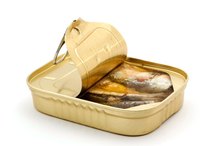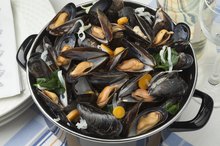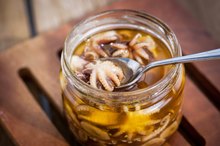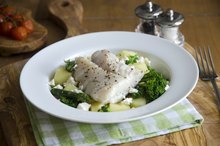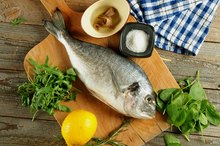What does fact checked mean?
At Healthfully, we strive to deliver objective content that is accurate and up-to-date. Our team periodically reviews articles in order to ensure content quality. The sources cited below consist of evidence from peer-reviewed journals, prominent medical organizations, academic associations, and government data.
- U.S. Food and Drug Administration: Calculate the Percent Daily Value for the Appropriate Nutrients
- Centers for Disease Control and Prevention: Sodium: The Facts
The information contained on this site is for informational purposes only, and should not be used as a substitute for the advice of a professional health care provider. Please check with the appropriate physician regarding health questions and concerns. Although we strive to deliver accurate and up-to-date information, no guarantee to that effect is made.
Nutrition Facts for Anchovy Fillets in Oil
People tend to have a love or hate relationship with anchovies. If you are one of those who love them, you'll be happy to know that they provide a wide variety of essential nutrients. However, anchovy fillets canned in oil are very high in sodium, so you should only eat them in moderation 1. Fresh anchovy fillets contain much less sodium and are, therefore, a healthier choice.
Tips
Anchovy Fillets Oil has 167 Calories and 20.00 g of Protein per 100 gram serving according to the nutrition facts provided by the USDA Food Composition Database.
Just the Basics
A 3-ounce serving of anchovies canned in oil provides 179 calories, 24.6 grams of protein and 8.3 grams of fat, including only 1.9 grams of saturated fat. This serving of anchovies also contains 72 milligrams of cholesterol. This is 49 percent of the daily value for protein, 13 percent of the DV for fat, 10 percent of the DV for saturated fat and 24 percent of the DV for cholesterol if you follow a 2,000-calorie diet.
Vital Vitamins
Nutrition Information for Kippers
Learn More
Anchovies are a vitamin-rich food, with each serving of canned anchovies providing 85 percent of the DV for niacin and between 10 and 20 percent of the DV for riboflavin, vitamin B-12, vitamin D, vitamin E and vitamin K. You need the B vitamins for healthy brain, liver and nervous system function. Vitamin D helps you absorb calcium and form strong bones. Vitamin E acts as an antioxidant and plays a role in immune function, while vitamin K is important for blood clotting.
Major Minerals
A serving of sardines canned in oil will also give you a mineral boost, providing more than 10 percent of the DV for potassium and magnesium, more than 20 percent of the DV for calcium, iron and phosphorus, as well as 83 percent of the DV for selenium. Potassium and magnesium both help control your blood pressure, while calcium helps with muscle and nerve function, and iron helps form red blood cells to carry oxygen from the lungs throughout your body. You need phosphorus and selenium for forming DNA.
Omega-3 Opportunity
Lobster Nutrition Information
Learn More
You should consume 500 milligrams per day of a combination of the essential omega-3 fats docosahexaenoic acid and eicosapentaenoic acid, according to the Academy of Nutrition and Dietetics. These fats may help lower your risk for heart disease. Each serving of anchovies provides you with 1,748 milligrams of EPA and DHA, or more than 3 days' worth of omega-3 fats.
Sodium Situation
The main drawback to consuming anchovy fillets in oil is their extremely high sodium content. A 3-ounce serving contains 3,120 milligrams of sodium, which is more than the 2,300-milligram daily limit for healthy people that the "Dietary Guidelines for Americans, 2010" recommends -- and more than double the recommended 1,500-milligram daily limit for people with high blood pressure. Consuming too much sodium increases your risk for high blood pressure and heart disease 3. To stay within the recommended sodium limit, either opt for fresh anchovies, which only contain about 88 milligrams of sodium per 3-ounce serving, or use just a sprinkle of canned anchovies in your favorite dishes to add a little bit of their characteristic flavor.
- The main drawback to consuming anchovy fillets in oil is their extremely high sodium content.
- To stay within the recommended sodium limit, either opt for fresh anchovies, which only contain about 88 milligrams of sodium per 3-ounce serving, or use just a sprinkle of canned anchovies in your favorite dishes to add a little bit of their characteristic flavor.
Related Articles
References
- USDA National Nutrient Database: Fish, Anchovy, European, Canned in Oil, Drained Solids
- American Pregnancy Association: Mercury Levels in Fish
- Centers for Disease Control and Prevention: Sodium: The Facts
- USDA National Nutrient Database: Fish, Anchovy, European, Raw
- Duyff RL, Mount JR, Jones JB. Sodium Reduction in Canned Beans After Draining, Rinsing. Journal of Culinary Science & Technology. 2011;9(2):106-112. doi: 10.1080/15428052.2011.582405.
- Haytowitz DB. Effect of Draining and Rinsing on the Sodium and Water Soluble Vitamin Content of Canned Vegetables. Nutrient Data Laboratory, Beltsville Human Nutrition Research Center, Beltsville, MD.
- United States Department of Agriculture and United States Department of Health and Human Services. Dietary Guidelines for Americans, 2015-2020. http://health.gov/dietaryguidelines/2015/guidelines/.
- Gropper SS, Smith JL, Groff JL. Advanced Nutrition and Human Metabolism. Sixth Edition. Belmont, CA. Wadsworth Publishing Company, 2013.
Writer Bio
Based in Massachusetts, Jessica Bruso has been writing since 2008. She holds a master of science degree in food policy and applied nutrition and a bachelor of arts degree in international relations, both from Tufts University.


